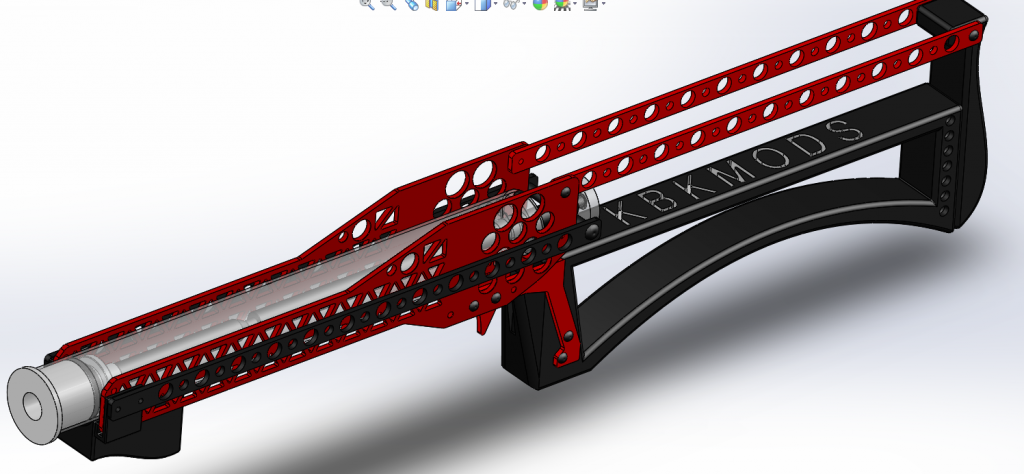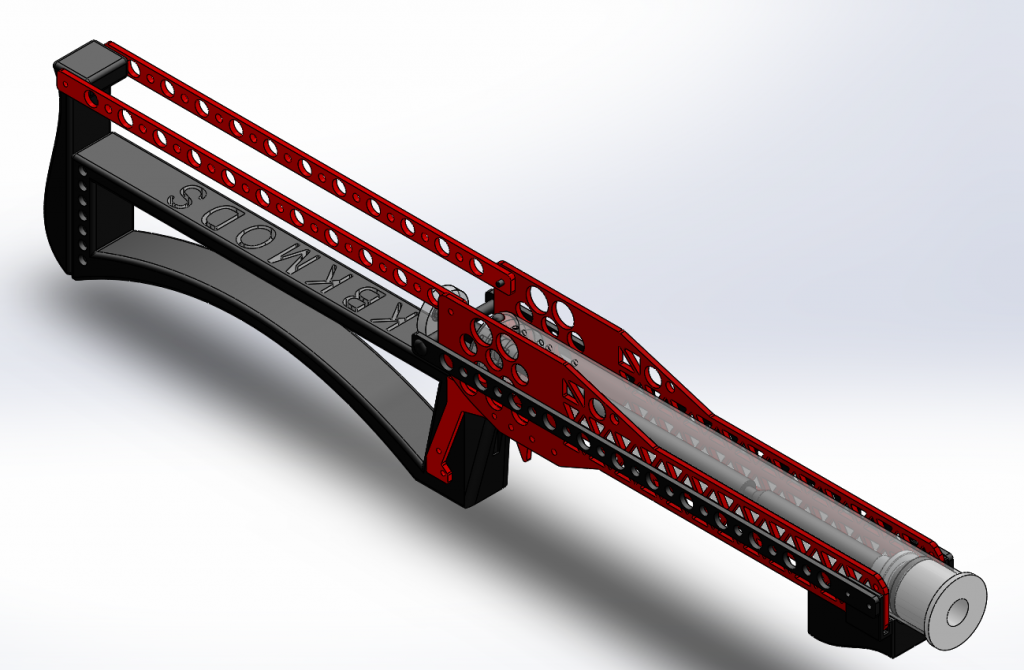Posted 16 February 2014 - 01:35 PM
Looking at this design as a whole, it seems pretty excessive for what seems to be a first time (Nerf) builder. Personally, I would remove all the decorative machining, at least until you are sure the design works. There are also quite a few other things that stuck out as concerning to me.
The trigger looks to have quite a few possible issues. The first one being the question of reach. I can't be sure just from looking, but it seems like you would really have to stretch your trigger finger in order to actually pull on the trigger. In my experience, the trigger shouldn't really stick out a whole lot beyond the line of the handle, as you do want your index finger to get a decent wrap around it. You can't pull a trigger if you're juts scraping it with the pad of your finger.
Still on the trigger, it also looks like it would pinch your middle finger when you pull it. Again, I can't be sure without seeing how far it swings, but I bet your hand is going to be migrating up that handle if you start to do anything like run around with the blaster.
This may be more questionable, but the angle of the front face of the trigger looks uncomfortable. Currently, it looks like it is angled backward pretty sharply. As you pull on the trigger, that's going to push downward on your index finger. And the angle will only get worse as the trigger rotates further backward. Generally, I like to have the front curve of the trigger to start bending forward again, at least until the point that the bottom-most as at least vertical when the trigger is fully pulled.
I also see a lot of potential problems with your pump-action system. Starting from the front, you always have to be careful when applying offset forces to a mechanism, such as having the pump grip significantly below the plunger rod. Pulling on the handle is going to generate significant torque that has to be canceled out somewhere. You also have to make sure your connection can handle that torque in addition to the linear forces. Additionally, I cant see any sort of guide or tracks for the pump. What happens if pull slightly downward on the pump? Would it just come off of the blaster completely? Moving backward, I would also remove the aforementioned holes in the rods/bars there.
The whole back end of the pump system also looks extremely dodgy to me. The images do not show it very well, but it looks like you just have a couple of screws through the bars, sticking inwards. The first problem is another of torques: what would stop the bars from just bending there? Or the whole bar just bowing outward? You also have to make sure that the screws are going to stay fairly centered vertically on that plate at the back of your plunger rod, or else you're also going to be torquing it as well. A better solution might be to have a standoff above and below the plunger rod, connected to both sides of the pump. That way, the potential bowing of the pump bars is greatly reduced and the forces on the plunger rod will stay vertically balanced.
There also appear to be a decent number of structural problems with the design as a whole. As roboman mentioned, your side plates don't reach the front of the plunger tube. This means that the bushing at the front of the plunger tube would be supported only by the thin walls of the plunger tube. This would probably be okay if you use aluminum for the tube, but it would be a very bad idea with polycarbonate. The way that the plunger tube is currently mount also looks like any motion on a barrel or hopper assembly, or any unintentional forces on them, are only supported by the mounting in the very back. That could potentially lead to a large stack of broken or cracked plunger tubes. I would also suggest some sort of horizontal support at the top of the side plates, like sticking a standoff between the holes that connect the top stock bars to the side plates.
I think you might also have some problems with your stock, particularly with how it connects with the rest of the blaster. Right now, all the support for the bottom of the stock comes from those two screws at the bottom of the handle. Transferring that force into the main frame of the blaster is going to come from shear forces. Those pieces on the handle on not very wide, and not very thick. Personally, I wouldn't be that comfortable stressing them like that. I think a lot of this problem could be averted by putting another screw between the two parts near the top of the handle.
There are a few other assorted things as well. It looks like the holes in the top bars on the stock don't line up. This isn't a problem on its own, but it might indicate other inconsistencies in the geometry. 7" of draw on a [k26] is probably overkill, I think you'd be better off with something closer to 6"-6.5". You might also want to check the unprimed spring length in the blaster. Springs may shorten up a bit from their new length after some use, and having a spring rattling around inside a blaster is annoying. Also, you might want to be careful with that sort of catch notch on your plunger rod. It has definitely been done successfully, but it usually means a thinner catch face, so you might want to be sure that you don't round over the edge too much, on either the plunger rod or the catch plate.
I know that this response might seem extremely critical, but I just wanted to point out some things I've learned from my experiences so they don't surprise you later. It's also how I think I communicate most clearly.
Please email me rather than sending a PM. I am DarthFreyr at gmail dot com
























